Great hornbill
| Great hornbill | |
|---|---|
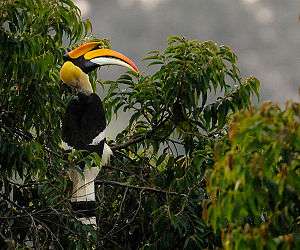 | |
| Perched on a Maesopsis eminii tree at Valparai, India | |
| Scientific classification | |
| Kingdom: | Animalia |
| Phylum: | Chordata |
| Class: | Aves |
| Order: | Bucerotiformes |
| Family: | Bucerotidae |
| Subfamily: | Bucerotinae |
| Genus: | Buceros |
| Species: | B. bicornis |
| Binomial name | |
| Buceros bicornis Linnaeus, 1758 | |
 | |
| Synonyms | |
|
Buceros homrai[2] | |
The great hornbill (Buceros bicornis) also known as the Great Indian Hornbill or Great Pied Hornbill, is one of the larger members of the hornbill family. It is found in the Indian Subcontinent and Southeast Asia. Its impressive size and colour have made it important in many tribal cultures and rituals. The great hornbill is long-lived, living for nearly 50 years in captivity. It is predominantly frugivorous, but is an opportunist and will prey on small mammals, reptiles and birds.
Description

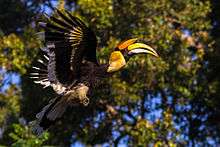

The great hornbill is a large bird, 95–130 cm (37–51 in) long, with a 152 cm (60 in) wingspan and a weight of 2.15–4 kg (4.7–8.8 lb). It is the heaviest, but not the longest, Asian hornbill. Females are smaller than males and have bluish-white instead of red eyes, although the orbital skin is pinkish. Like other hornbills, they have prominent "eyelashes".
The most prominent feature of the hornbill is the bright yellow and black casque on top of its massive bill. The casque appears U-shaped when viewed from the front, and the top is concave, with two ridges along the sides that form points in the front, whence the Latin species epithet bicornis (two-horned). The back of the casque is reddish in females, while the underside of the front and back of the casque is black in males.
The casque is hollow and serves no known purpose, although it is believed to be the result of sexual selection. Male hornbills have been known to indulge in aerial casque butting, with birds striking each other in flight.[3] The male spreads the preen gland secretion, which is yellow, onto the primary feathers and bill to give them the bright yellow colour.[4] The commissure of the beak is black and has a serrated edge which becomes worn with age.
The wing beats are heavy and the sound produced by birds in flight can be heard from a distance. This sound has been likened to the puffing of a steam locomotive starting up. The flight involves stiff flaps followed by glides with the fingers splayed and upcurled. They sometimes fly at great height over forests.[5][6]

Classification
The species was formerly broken into subspecies cavatus, from the Western Ghats, and homrai, the nominate form from the sub-Himalayan forests. The subspecies from Sumatra was sometimes called cristatus.[7] Variation across populations is mainly in size, Himalayan birds being larger than the those from further south, and the species is now usually considered monotypic.[8][9]
Like other members of the hornbill family, they have highly pneumatized bones, with hollow air cavities extending to the tips of the wing bones. This anatomical feature was noted by Richard Owen, who dissected a specimen that died at the Zoological Society of London in 1833.[10]
Distribution and habitat
Great hornbills are found in the forests of India, Bhutan, Nepal, Mainland Southeast Asia, Indonesian Island of Sumatra and North eastern region of India. The distribution of the species is fragmented over its range in the Indian Subcontinent and Southeast Asia. In the Subcontinent they are found in a few forest areas in the Western Ghats and in the forests along the Himalayas. Their distribution extends into Thailand, Burma, Malaya, and Sumatra.[11] A small feral population is found in Singapore. Their habitat is dense old growth (unlogged) forests in hilly regions.[12][13] They appear to be dependent on large stretches of forest, unlike many of the smaller hornbills.[14]
In Thailand the home range of males was found to be about 3.7 km2 during the breeding season and about 14.7 km2 during the non-breeding season.[15]
Behaviour and ecology
Food and feeding

Great hornbills are usually seen in small parties, with larger groups sometimes aggregating at fruit trees. A congregation of 150 to 200 birds has been recorded in southeastern Bhutan.[5] In the wild, the great hornbill's diet consists mainly of fruit. Figs are particularly important as a food source.[16] Vitex altissima has been noted as another important food source. Great hornbills also forage on lipid-rich fruits of the Lauraceae and Myristicaceae families such as Persea, Alseodaphne and Myristica.[17] They obtain the water that they need entirely from their diet of fruits. They are important dispersers of many forest tree species.[18] They will also eat small mammals, birds,[19] small reptiles and insects.[20] Lion-tailed macaques have been seen to forage alongside these hornbills.[21]
They forage along branches, moving along by hopping, looking for insects, nestling birds and small lizards, tearing up bark and examining them. Prey are caught, tossed in the air and swallowed. A rare squirrel, the Travancore flying squirrel (Petinomys fuscocapillus) has been eaten, and Indian scops owl (Otus bakkamoena), jungle owlet (Glaucidium radiatum) and Sri Lanka green pigeon (Treron pompadora) have been taken as prey in the Western Ghats.[22]
Breeding
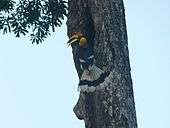
During the breeding season (January to April[8]) great hornbills become very vocal. They make loud duets, beginning with a loud "kok" given about once a second by the male, to which the female joins in. The pair then calls in unison, turning into a rapid mixture of roars and barks.[22] They prefer mature forests for nesting. Large, tall and old trees, particularly emergents that rise above the canopy, seem to be preferred for nesting.[23][24] They form monogamous pair bonds and live in small groups of 2-40 individuals. Group courtship displays involving up to 20 birds have been observed.[25]
The female hornbill builds a nest in the hollow of a large tree trunk, sealing the opening with a plaster made up mainly of feces.[7][26][27] She remains imprisoned there, relying on the male to bring her food, until the chicks are half developed. During this period the female undergoes a complete moult. The young chicks have no feathers and appear very plump. The mother is fed by her mate through a slit in the seal. The clutch consists of one or two eggs, which she incubates for 38–40 days. The female voids feces through the nest slit, as do the chicks from the age of two weeks.[22] Once the female emerges from the nest, the chicks seal it again.[8]
The young birds have no trace of a casque. After the second year the front extremity separates from the culmen, and in the third year it becomes a transverse crescent with the two edges growing outwards and upwards, while the anterior widens to the width of the rear end. Full development takes five years.[28]
Roosting
Roost sites are used regularly and birds arrive punctually at sunset from long distances, following the same routes each day. Several tall trees in the vicinity may be used, the birds choosing the highest branches with little foliage. They jockey for position until late at dusk. When sleeping they draw their neck back and the bill is held upwards at an angle.[5]
In captivity

Very few hornbills are held in captivity, and few of them breed well. Females at the nests are extremely easy to capture, and birds caught in the wild are mostly female. Breeding them in captivity has been notoriously difficult, with fewer than a dozen successful attempts. Their extreme selectivity for mates and their long and strong pair bonds make them difficult to maintain for breeding.[29][30][31][32]
In captivity hornbills eat fruits and meat, a healthy diet consisting mostly of fruit and some source of protein. A few have been tamed in captivity but hornbill behavior in captivity is described as highly strung. Captive specimens may bask in the sun with outstretched wings.[33]
Conservation status
Due to habitat loss and hunting in some areas, the great hornbill is evaluated as near threatened on the IUCN Red List of Threatened Species.[1] It is listed in Appendix I of CITES. Declines in population have been noted in many areas such as Cambodia.[34] Molecular approaches to the study of their population diversity have been attempted.[35]
In culture
Tribal peoples threaten the great Indian hornbill by hunting it for its various parts. The beaks and head are used in charms and the flesh is believed to be medicinal. Young birds are considered a delicacy.[5] Tribesmen in parts of northeastern India and Borneo use the feathers for head-dresses, and the skulls are often worn as decorations.[36][37] The Sema Nagas consider the flesh unfit for eating, believing that it produces sores on their feet, as in the bird. When dancing with the feathers of the hornbill, they avoid eating vegetables, as doing so is also believed to produce the same sores on the feet.[38] Among the Zomi, a festival without a hornbill feather is incomplete.[39] Conservation programmes have attempted to provide tribes with feathers from captive hornbills and ceramic casques to substitute for natural ones.[40]
The great hornbill is called homrai in Nepal (hence the name of the Himalayan subspecies) and banrao, both meaning "king of the forest". It is called "Vezhaambal" in Malayalam. [41]
 A Nishi tribesman from Arunachal Pradesh wearing the traditional head-dress featuring an artificial hornbill beak
A Nishi tribesman from Arunachal Pradesh wearing the traditional head-dress featuring an artificial hornbill beak A Paite tribesman wearing a hornbill feather in his head-dress.
A Paite tribesman wearing a hornbill feather in his head-dress. Female
Female
Use as a symbol
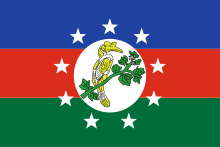
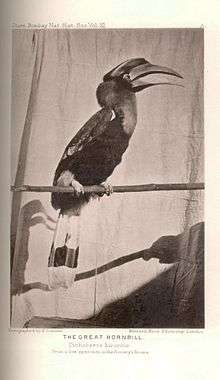
The great hornbill is the state bird of Chin State in Myanmar, and of Kerala and Arunachal in India.
A great hornbill called William (pictured) was the model for the logo of the Bombay Natural History Society (BNHS) and the name of their building. Sir Norman Kinnear described William as follows in the obituary of W S Millard:[42] “Every visitor to the Society's room in Apollo Street will remember the great Indian Hornbill, better known as the "office canary" which lived in a cage behind Millard's chair in Phipson & Co.'s office for 26 years and died in 1920. It is said its death was caused by swallowing a piece of wire, but in the past "William" had swallowed a lighted cigar without ill effects and I for my part think that the loss of his old friend was the principal cause."[43][44]
References
- 1 2 BirdLife International (2013). "Buceros bicornis". IUCN Red List of Threatened Species. Version 2013.2. International Union for Conservation of Nature. Retrieved 26 November 2013.
- ↑ Hodgson,BH (1833). "Description of the Buceros Homrai of the Himalaya". Asiatic Researches. 18 (2): 169–188.
- ↑ Raman, T. R. Shankar (1998). "Aerial casque-butting in the Great Hornbill Buceros bicornis" (PDF). Forktail. 13: 123–124. Archived from the original (PDF) on 7 October 2007. Retrieved 9 March 2014.
- ↑ Kemp, A. C. (2001). "Family Bucerotidae (hornbills)". In del Hoyo, J; Elliott A; J Sargatal. Handbook of the birds of the world. Vol. 6. Mousebirds to hornbills. Lynx Edicions, Barcelona. pp. 436–523.
- 1 2 3 4 Ali, S; S D Ripley (1983). Handbook of the birds of India and Pakistan. 4 (2nd ed.). Oxford University Press. pp. 143–146. ISBN 978-0-19-562063-4.
- ↑ Blanford WT (1895). The Fauna of British India, Including Ceylon and Burma. Birds. 3. Taylor and Francis, London. pp. 142–146.
- 1 2 Baker, ECS (1927). The Fauna of British India, Including Ceylon and Burma. Birds. 4 (2nd ed.). Taylor and Francis, London. pp. 284–285.
- 1 2 3 Rasmussen, PC; JC Anderton (2005). Birds of South Asia: The Ripley Guide. Volume 2. Smithsonian Institution and Lynx Edicions. pp. 273–274.
- ↑ Deignan, HG (1945). "The birds of northern Thailand". Bulletin of the United States National Museum. 186: 1–616. doi:10.5479/si.03629236.186.1.
- ↑ Owen, Richard (1836). "On the Anatomy of the concave Hornbill, Buceros cavatus, Lath". Transactions of the Zoological Society of London. 1 (2): 117–122. doi:10.1111/j.1096-3642.1835.tb00609.x.
- ↑ Robinson, H.C.; Chasen, F.N. (1939). The Birds of the Malay Peninsula. Volume IV: The Birds of the Low-Country Jungle and Scrub (PDF). Witherby: London. pp. 90–91.
- ↑ Datta, A. (1998). "Hornbill abundance in unlogged forest, selectively logged forest and a forest plantation inArunachal Pradesh, India". Oryx. 32 (4): 285–294. doi:10.1046/j.1365-3008.1998.d01-58.x.
- ↑ Whistler, Hugh (1949). Popular handbook of Indian birds (4th ed.). Gurney and Jackson, London. pp. 304–306. ISBN 978-1-4067-4576-4.
- ↑ Raman T R Shankar; D Mudappa (2003). "Correlates of hornbill distribution and abundance in rainforest fragments in the southern Western Ghats, India". Bird Conservation International. 13 (3): 199–212. doi:10.1017/S0959270903003162.
- ↑ Poonswad, P.; Tsuji, A. (1994). "Ranges of males of the Great Hornbill Buceros bicornis, Brown Hornbill Ptilolaemus tickelli, and Wreathed Hornbill Rhyticeros undulatus in Khao Yai National Park, Thailand". Ibis. 136: 79–86. doi:10.1111/j.1474-919X.1994.tb08133.x.
- ↑ Datta, Aparajita Datta; G. S. Rawat (2003). "Foraging Patterns of Sympatric Hornbills during the Nonbreeding Season in Arunachal Pradesh, Northeast India". Biotropica. 35 (2): 208–218. doi:10.1646/02103.
- ↑ Kannan, Ragupathy Kannan; Douglas A. James (1999). "Fruiting Phenology and the Conservation of the Great Pied Hornbill (Buceros bicornis) in the Western Ghats of Southern India". Biotropica. 31 (1): 167–177. doi:10.1111/j.1744-7429.1999.tb00127.x.
- ↑ Sethi, Pia; Howe H (2009). "Recruitment of Hornbill-Dispersed Trees in Hunted and Logged Forests of the Indian Eastern Himalaya". Conservation Biology. 23 (3): 710–718. doi:10.1111/j.1523-1739.2008.01155.x. PMID 19220369.
- ↑ Wood,WS (1927). "Is the Large Hornbill Dichoceros bicornis carnivorous?". Journal of the Bombay Natural History Society. 32 (2): 374.
- ↑ Poonswad, Pilai; Atsuo Tsuji & Narong Jirawatkavi (2004). "Estimation of nutrients delivered to nest inmates by four sympatric species of hornbills in Khao Yai National Park, Thailand" (PDF). Ornithological Science. 3 (2): 99–112. doi:10.2326/osj.3.99.
- ↑ Fooden Jack (1975). "Taxonomy and evolution of liontail and pigtail macaques (Primates:Cercopithecidae)". Fieldiana Zoology. 67: 84.
- 1 2 3 Kannan, Ragupathy; James,Douglas A (1997). "Breeding biology of the Great Pied Hornbill (Buceros bicornis) in the Anaimalai Hills of southern India". Journal of the Bombay Natural History Society. 94 (3): 451–465.
- ↑ James, DA; R Kannan (2009). "Nesting habitat of the Great Hornbill (Buceros bicornis) in the Anaimalai Hills of southern India". Wilson Journal of Ornithology. 121 (3): 485–492. doi:10.1676/08-022.1.
- ↑ Bingham,CT (1879). "Notes on the nidification of some Hornbills". Stray Feathers. 8 (6): 459–463.
- ↑ Hutton,Angus F (1986). "Mass courtship display by Great Pied Hornbill Buceros bicornis". Journal of the Bombay Natural History Society. 83 (4): 209–210.
- ↑ James, D.A.; Kannan, R. (2007). "Wild Great Hornbills (Buceros bicornis) do not use mud to seal nest cavities". Wilson Journal of Ornithology. 119 (1): 118–121. doi:10.1676/06-064.1.
- ↑ Poulsen, Holger (1970). "Nesting Behaviour of the Black-Casqued Hornbill Ceratogymna atrata (Temm.) and the Great Hornbill Buceros bicornis L". Ornis Scandinavica. 1 (1): 11–15. doi:10.2307/3676330. JSTOR 3676330.
- ↑ Tickell,SR (1864). "On the hornbills of India and Burmah". Ibis. 6 (2): 173–182. doi:10.1111/j.1474-919X.1864.tb07860.x.
- ↑ Crofoot, M; M Mace; J Azua; E MacDonald; NM Czekala (2003). "Reproductive Assessment of the Great Hornbill (Buceros bicornis) by Fecal Hormone Analysis" (PDF). Zoo Biology. 22 (2): 135–145. doi:10.1002/zoo.10083.
- ↑ Bohmke BW (1987). "Breeding the great Indian hornbill at the St. Louis Zoological Park, USA". Avicultural Magazine. 93: 159–61.
- ↑ de Ruiter M (1998). "The great Indian hornbill: a breeding attempt". AFAWatchbird. 25: 34–35.
- ↑ Golding RR, Williams MG (1986). "Breeding the great Indian hornbill at the CotswoldWild Life Park". International Zoo Yearbook. 24/25: 248–52. doi:10.1111/j.1748-1090.1985.tb02548.x.
- ↑ Ellison,BC (1923). "Notes on the habits of a young Hornbill". Journal of the Bombay Natural History Society. 29 (1): 280–281.
- ↑ Setha, Tan (2004). "The status and conservation of hornbills in Cambodia". Bird Conservation International. 14 (1): S5–S11. doi:10.1017/s0959270905000183.
- ↑ Chamutpong, S.; Saito, D.; Viseshakul, N.; Nishiumi, I.; Poonswad, P. & Ponglikitmongkol, M. (2009). "Isolation and characterization of microsatellite markers from the great hornbill, Buceros bicornis". Molecular Ecology Resources. 9 (2): 591–593. doi:10.1111/j.1755-0998.2008.02447.x. PMID 21564700.
- ↑ Hastings, James (1910). Encyclopaedia of Religion and Ethics. 3. T&T Clark, Edinburgh. p. 442. ISBN 978-0-567-06512-4.
- ↑ Hastings, James (1908). Encyclopaedia of Religion and Ethics. 1. T&T Clark, Edinburgh. p. 505. ISBN 978-0-567-06512-4.
- ↑ Hutton, JH (1921). The Sema Nagas. Macmillan and Co, London. p. 92.
- ↑ Dr. Neihsial, Tualchin, History and Culture of the Zoumi, 1993
- ↑ http://www.firstpost.com/india/artificial-beaks-save-hornbills-from-extinction-in-arunachal-205740.html
- ↑ Bingham,CT (1897). "The great indian hornbill in the wild state". Journal of the Bombay Natural History Society. 11 (2): 308–310.
- ↑ Spence,RA (1920). "The Great Indian Hornbill (Dichocerros bicornis)". Journal of the Bombay Natural History Society. 27 (1): 174.
- ↑ Kinnear, N.B. (1952). "W. S. Millard". Journal of the Bombay Natural History Society. 50: 910–913.
- ↑ Phipson,HM (1897). "The great indian hornbill in captivity". Journal of the Bombay Natural History Society. 11 (2): 307–308.
Other sources
- Kannan, R. (1994). "Ecology and Conservation of the Great Pied Hornbill (Buceros bicornis) in the Western Ghats of southern India". Ph.D. Thesis, University of Arkansas, Fayetteville.
- Kannan, Ragupathy (1994). "Conservation ecology of the Great Hornbill in the Western Ghats, southern India". OBC Bull. 19:13.
- Poonswad, P. (1995). "Nest site characteristics of four sympatric species of hornbills in Khao Yai National Park, Thailand". Ibis 137: 183-191.
- Poonswad, P. and Tsuji, A. (1994). "Ranges of males of the Great Hornbill (Buceros bicornis), Brown Hornbill (Ptilolaemus tickelli) and Wreathed Hornbill (Rhyticeros undulatus) in Khao Yai National Park, Thailand". Ibis 136: 79-86.
External links
| Wikimedia Commons has media related to Buceros bicornis. |
- Great Hornbill videos, photos & sounds on the Internet Bird Collection
- CITES Guide (PDF)
- Great Horbill: Saint Louis Zoo
